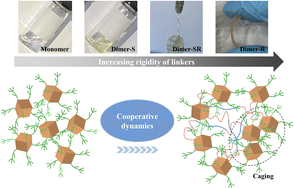Dimerization of sub-nanoscale molecular clusters affords broadly tuneable viscoelasticity above the glass transition temperature†
Abstract
Materials with promising mechanical performance generally demonstrate requirements for the critical sizes of their key building units, e.g. entanglements and crystal grains. Herein, only with van der Waals interaction, viscoelasticity with broad tunability has been facilely achieved below the critical size limits: the dimers of ∼1 nm polyhedral oligomeric silsesquioxane (POSS) with Mw < 4 kD and size < 5 nm, which demonstrate distinct material physics compared to that of polymer nanocomposites of POSS. The dimeric POSSs are confirmed by scattering and calorimetrical measurements to be intrinsic glassy materials with glass transition temperatures (Tgs) lower than room temperature. From rheological studies, their viscoelasticity can be broadly tuned through the simple tailoring of the dimer linker structures above their Tg. In dimer bulks, each POSS cluster is spatially confined by the POSSs from other dimers and therefore, the correlation of the dynamics of the two linked POSS clusters, which, as indicated by dynamics analysis, is regulated by the length and flexibilities of linkers, contributes to the caging dynamics of POSS confined by their neighbours and the resulting unique viscoelasticity. Our discoveries update the understanding of the structural origin of viscoelasticity and open avenues to fabricate structural materials from the design of sub-nanoscale building blocks.



 Please wait while we load your content...
Please wait while we load your content...